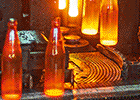This was announced by Anton Mor, General Director of Siberian Glass LLC (an asset of RATM Holding), within the framework of a round table dedicated to the processing of MSW in the region.
Let us recall that the economic and environmental agendas at "Sibglass" are closely interconnected. It is technologically more difficult to produce glass containers without cullet - using it, they improve the characteristics of glass. One ton of cullet replaces 1.2 tons of minerals. Since glass is recyclable an unlimited number of times, the rate of depletion of mineral reserves slows down. In addition, the melting point of cullet is not as high as a mixture of sand, soda and dolomite: every 10% of recyclable materials in the batch reduces energy consumption by 3%. As a result, the emission of carbon dioxide is reduced, and glass furnaces burn out not after 7-10 years, but after 12-15 years.
- According to our estimates, 55 thousand tons of glass containers are thrown out annually in the Novosibirsk region, and we are ready to recycle all this amount. Today, cullet mainly comes from MSW landfills, where it enters in a mixed waste stream: during transportation, the contents of garbage trucks are compressed, as a result, the container is crushed into fragments. Collecting them in the absence of optical separators is laborious and time consuming. It is not profitable for companies specializing in the supply of recyclable materials to deal with cullet. Therefore, only 10-12 thousand tons are returned for processing. "Sibglass" - the largest recycler of glass waste in Siberia - sells no more than 5 thousand tons, the rest is exported from the region, and there is a short transport leg.
"Sibglass" considers it unacceptable to dispose of useful fractions of MSW at a landfill. It is obvious that the primary sorting of waste at the source of generation, primarily apartment buildings, will allow solving the so-called “garbage problem” in the most rational way - by improving the quality of the secondary material resource, and increasing the share of recycled waste. However, according to Anton Mohr, there are not enough containers for the separate collection of MSW in Novosibirsk, and there is not much glass there either:
- Most of Novosibirsk residents put all the garbage in one bag and throw it into the unsorted waste bin. At the household level, people have not formed the habit of separating plastic, paper, glass, metal, etc., for which the state needs to promote the correct attitude towards MSW, including initiating information campaigns in the media and educational projects for children. Thus, sorting MSW will become part of natural behavior.
Another incentive measure for citizens could be the introduction of a collateral value for containers (and the cost of cullet for utilizers will not rise) - when a deposit is provided in the retail price of the goods, which will be taken into account when paying at the checkout at a retail outlet if the buyer returns the bottle to economic circulation.
According to Anton Mora, Sibglass is ready to participate in the development of culture and the creation of an infrastructure for the treatment of MSW in the Novosibirsk region. The plant conducts excursions for organized groups of eco-activists, demonstrating the entire process of recycling cullet. The company has opened collection points for glass waste (contrary to popular belief, the townspeople hand over them, guided by the principles of responsible consumption), cooperates with the HoReCa sector: it picks up glass containers from restaurants, hotels, entertainment complexes. At the same time, the enterprise installed containers for the selective collection of MSW in Tomsk; in Khabarovsk, Irkutsk and Krasnoyarsk there are Sibglass bases for the accumulation of cullet.
























